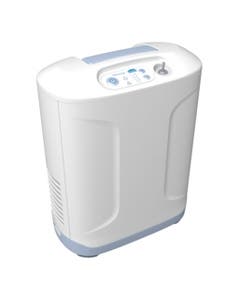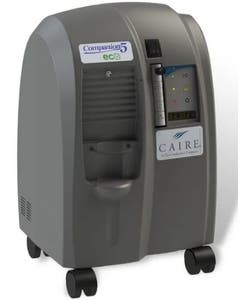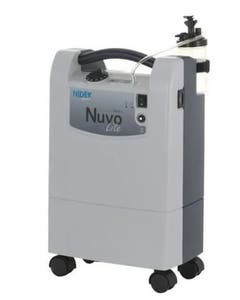Bronchitis is one of many respiratory illnesses that may be treated with oxygen therapy. Oxygen therapy helps lung function when breathing is compromised by illnesses such as bronchitis. A doctor may prescribe oxygen therapy as a short-term treatment to help with symptoms.
What Is Bronchitis?
Bronchitis is an inflammation of the lining of the bronchial tubes, which carry air to and from the lungs. People who have this illness often cough up thickened mucus, which can be discolored. It may be either acute or chronic.
Often developing from a cold or other respiratory infection, acute bronchitis is very common. Chronic bronchitis, a more serious condition, is a constant irritation or inflammation of the lining of the bronchial tubes, often due to smoking.
What Are the Symptoms of Bronchitis?
Both acute and chronic bronchitis have the same symptoms in varying degrees of severity:
- A persistent and productive cough with clear, white, yellowish-grey, or green sputum, in some instances streaked with blood
- Fatigue
- Shortness of breath
- Fever and chills
- Chest pain or discomfort, especially when breathing or coughing
Most of the typical symptoms of acute bronchitis mimic those of a bad cold, including headache and body aches. When these symptoms persist for a long period of time, up to several months, then the acute bronchitis infection may be considered chronic, especially if there are periods of recovery and relapse over a period of years.
What Causes Bronchitis?
A viral infection is what causes acute bronchitis. Because antibiotics do not kill viruses, doctors may seek other types of treatment or recommend bed rest for healing. In most cases, patients will heal on their own as the body’s immune system fights the virus.
Chronic bronchitis, on the other hand, is the result of a viral infection that is worsened by exposure to harmful pollutants introduced to the lungs. Patients with chronic bronchitis often have long-term exposure to harmful airborne materials that elevate acute bronchitis to chronic.
Habitual cigarette smoking, living in an area with severe air pollution, and long-term exposure to workplaces with harmful airborne particles or toxic gases can cause chronic bronchitis.
Types of Bronchitis
Acute Bronchitis
Acute bronchitis is very common. Symptoms usually last a few weeks. Most patients with acute bronchitis make a full recovery without any medical attention. In some instances, cases of acute bronchitis may be dismissed as a common cold by the patient.
Much like a bad cold or flu acute bronchitis weakens patients and leaves them with a stuffy nose, a sore throat, and a low-grade fever. The feeling of being so fatigued for a long period of time and an enduring cough is usually the indication that you have a bug worse than a cold or flu.
Even with acute bronchitis, a cough can be stubborn, often lasting for several weeks after all other symptoms have passed. Because the bronchial tubes have been inflamed for so long, it takes time for swelling to subside.
Chronic Bronchitis
Chronic bronchitis occurs when the inflammation of the airways becomes a long-term health issue. This type is most common among smokers. The condition becomes chronic when the patient experiences a persistent cough for at least 3 months for up to 2 years in a row.
Chronic bronchitis is part of a family of lung diseases known as COPD or chronic obstructive pulmonary diseases. This class of respiratory illnesses interrupts normal airflow into the lungs. Often other lung conditions can cause chronic bronchitis such as asthma or tuberculosis. A doctor will determine if the bronchitis has reached a chronic stage by measuring the lung’s ability to move air.
How Long Does Bronchitis Last?
Chronic bronchitis may last between a few months to many years. Most patients with chronic bronchitis will go through periods of brief recovery with relapses. Chronic bronchitis leaves the lungs vulnerable to infection, so patients may develop new symptoms after they have recovered. Often symptoms will reappear during flu and cold seasons when airborne germs are more prevalent.
Older adults may experience more severe symptoms over a longer duration of time. These symptoms can include rapid breathing and confused thinking. Elderly individuals may also be at a higher risk for complications, such as pneumonia.
Fortunately, there are steps a patient with chronic bronchitis can take to relieve symptoms and possibly reach full recovery.
How Do You Treat Bronchitis?
Medication
Most medications for treating this illness help the patient manage the symptoms. Most lung infections are viral, so antibiotics are not helpful. Doctors can only provide some relief with medications. Medicines can help with persistent coughing which can also cause chest pain in some patients. Along with cough suppressants, bronchodilators can help reduce wheezing and assist with the flow of air from the lungs.
Pain medications can help reduce the pain, fever and inflammation associated with bronchial episodes. Antihistamines are another option to help open up the airway for easier breathing. A doctor may also prescribe steroids to reduce lung inflammation.
Expectorants can also help clear the mucus from the airway to promote normal breathing. A combination of over-the-counter and prescriptions medications help most patients with acute bronchitis manage the discomfort until recovery.
Oxygen Therapy
Another treatment option for patients, especially those with chronic bronchitis is oxygen therapy. Oxygen therapy uses supplemental oxygen, either from oxygen tanks or an oxygen concentrator to promote healthy breathing with a flow of pure oxygen to the lungs.
Oxygen therapy may only be recommended when a patient has reached a stage of chronic bronchitis when normal breathing is no longer possible. Regular use of pure oxygen helps make breathing easier and reduces coughing and other chronic bronchitis symptoms. Pure oxygen can also help heal the lungs so that patients can reach recovery faster.
A doctor will recommend flow settings and oxygen therapy durations for patients on supplemental oxygen.
How to Diagnose Acute Bronchitis?
Most patients with acute bronchitis might mistake the symptoms for a common cold or flu. If symptoms persist for a long period, you may want to get the opinion of your doctor.
To diagnose acute bronchitis a doctor will:
- Order a blood test to look for signs of bacterial infection
- Order a chest X-ray to determine if there’s fluid in your bronchial tubes
- Perform a spirometry test, also called a pulmonary function test to measure lung function. This test is also used to diagnose asthma and upper respiratory tract infections.
- If your symptoms are severe, your doctor may request a sputum culture, or a sample of the mucus you cough up
Risks and Complications Related to Bronchitis
The possibility of getting bronchitis is related to several risk factors including:
- Smoking
- A family history of respiratory diseases
- Exposure to airborne pollutants
- Pre-existing conditions such as asthma or allergies
While family history is unavoidable, anyone concerned with reducing the risk of bronchitis can quit smoking and stay away from areas such as a workplace where airborne pollutants are day to day.
The complications of this illness include the potential for other lung diseases, especially for those who are older or have other risk factors. Patients with bronchitis are at high risk for pneumonia and heart problems associated with strained breathing from weakened lungs. Pneumonia develops in about 5% of patients with bronchitis.
How Do I Cope with Bronchitis?
Managing this illness can be difficult, especially if you live an active lifestyle. Along with avoiding risk factors, patients can follow their doctor’s recommendations for treatment.
Patients should take their medications as prescribed. They should follow bedrest recommendations and avoid strenuous activity until they recover. Some patients may also find oxygen therapy helpful, especially if the bronchitis has reached the chronic stage.
Your doctor will know best whether oxygen therapy will be an ideal treatment and will suggest either supplemental oxygen in a tank or an oxygen concentrator. Your doctor will write a prescription for flow settings and will provide instructions for when and how often you should use supplemental oxygen.
Does Oxygen Therapy Help with Bronchitis Treatment?
Oxygen therapy can help open up airways and allow for normal breathing to occur. Your doctor will only prescribe oxygen therapy if through testing it is determined that your lungs are not receiving enough oxygen.
If prescribed medications are not helping you feel better, low levels of oxygen therapy may also be used to help with breathing. In some instances, chronic bronchitis may actually reduce oxygen levels. Symptoms may include bluish coloring around the fingernails, indicating that your lungs are not performing well enough to saturate oxygen throughout the body. Under these circumstances, a doctor will highly recommend oxygen therapy to raise oxygen levels.
Oxygen Therapy During Bronchitis
If you are prescribed oxygen therapy for your bronchitis you have two choices of supplemental oxygen.
Oxygen tanks must be replenished regularly when the tanks become empty. They can be bulky and are highly flammable because the oxygen is under high pressure. Oxygen tanks can also get expensive with each new tank required if insurance does not cover the cost.
Oxygen concentrators are the preferred choice for anyone managing a respiratory illness long-term. They convert ambient air into pure oxygen, so you are never replenishing empty tanks.
You can find oxygen concentrators at most medical supply stores. You can also shop with your prescription online. The Oxygen Concentrator Supplies Shop provides the leading brands of oxygen concentrators in both home and portable models. Our knowledgeable staff can help answer all of your questions and assist you in choosing an oxygen concentrator that best fits your needs.
How Often Should an Oxygen Concentrator Be Cleaned?
If you have to use an oxygen concentrator long-term, then you need to follow a few cleaning guidelines to ensure lasting performance.
- Check your filters to make sure they are clean and change them as needed
- Clean the outside of your oxygen concentrator when it gets dusty to prevent debris or dust from getting into the intake ducts
- Make sure to clean your mask, nasal cannula and tubing after every use to prevent bacterial growth and other germs. Replace these accessories if you notice any damage.
- If you use a humidifier with your oxygen concentrator, be sure the clean the humidifier bottle after every use to prevent germs.
For information on taking care of your oxygen concentrator while it takes care of you, see the informative article: Do oxygen concentrators need maintenance?
How to Avoid Bronchitis While on Oxygen Therapy
If you are currently using oxygen therapy, you can take steps to avoid bronchitis.
- Get vaccinated for the seasonal flu
- Keep your nasal cannula, mask and tubing clean
- Avoid smoking
- See your doctor right away if you experience the symptoms of bronchitis
- Use a humidifier with your oxygen concentrator
- Use nasal moisturizer during dry winter months
This post was originally published on January 28, 2022, and updated on January 11, 2024.








